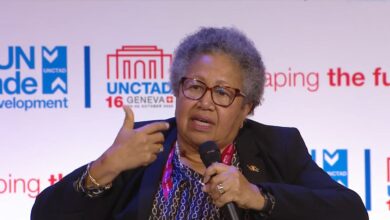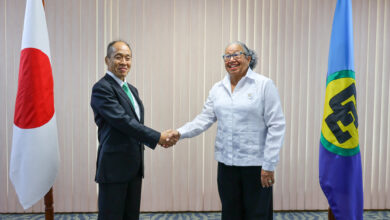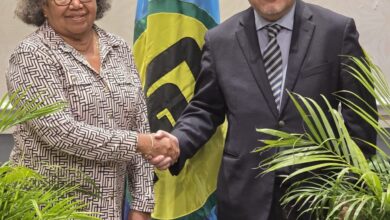Some of the region’s leading experts and researchers were today huddled at the University of the West Indies with one sole purpose: to find a coordinated, practical, regional response to the unwelcomed guest lining our coveted beaches.
And it has been long in coming. Some observers would argue much too late, given growing, unfair international media reports that paint a one-sided account of stinking piles of sargassum weed taking over the highlight of every Caribbean dream vacation.
Never mind the inconvenience to locals who have to live with the unrelenting menace daily.
The seaweed phenomenon is not new or exclusive to our Caribbean that grappled with a massive influx of the drifting, thick, brown weed in 2011.
But according to Vice Chancellor of the University of the West Indies, Professor Sir Hilary Beckles, not only is it the “new normal” but with “10,000 tons of deposits [of sargassum] on our beaches across the region daily”, this latest invasion amounts to an international crisis that represents the single greatest threat to the region’s bread and butter industry.
Against this backdrop, we can’t help but ponder why today’s think tank of some of our best minds was not held sooner. For though some speakers suggested the UWI had been working assiduously behind the scenes, it is of little comfort when our image is fast being tarnished, and livelihoods and economies are at stake.
Too often, this region is caught not being proactive, but reactive to matters critical to its well-being, giving leeway to the ill-informed to give the impression the sky is falling, as Chicken Little would have had his peers believe.
While we note the work being done by our own university, the absence of timely, accurate information to the public it serves does no good.
The seaweed has been piling up, deterring scores from our shores.
Hence, we welcome today’s exchange of information as a significant step for the region to find home-grown answers to the problem at its doorsteps.
If we can get an idea of what is causing the problem, then we can better respond as a nation and a region in a concerted way. A plan of action is critical.
From the UWI vice chancellor came noteworthy recommendations: a Sargassum Support Fund which would allow the international community to financially support the region’s effort to better control the phenomenon.
He also made a case for a sargassum emergency agency to coordinate the region’s response. Sir Hilary noted that the UWI was well placed to house this facility –– a point worth considering, given the work already done by the Centre For Resource Management And Environmental Studies (CERMES).
But the spotlight is on tourism and our stakeholders have an urgent job to do, especially when countries have pinned their hope of economic recovery after a crippling recession on the sector.
Barbados Hotel & Tourism Association (BHTA) president Sue Springer puts it best: “We cannot bury our heads in sargassum.”
Barbados and its regional neighbours must harness the power of all media –– social and otherwise –– to spread the message that not all our beaches are affected by the natural phenomenon, and that there’s yet much to do on a Caribbean vacation.
Also noteworthy were recommendations for local and regional farmers to see the influx of the seaweed as an opportunity to develop cheaper fertilizers and mulch. We anxiously await further research on the possibilities from the UWI in this regard.
But like with all things in this region, we’re never short of talk.
We hope that the recommendations will not be filed away in a cabinet at the UWI. Action on an effective plan that will benefit all affected sectors, protect our resources and safeguard our economies is needed now!






